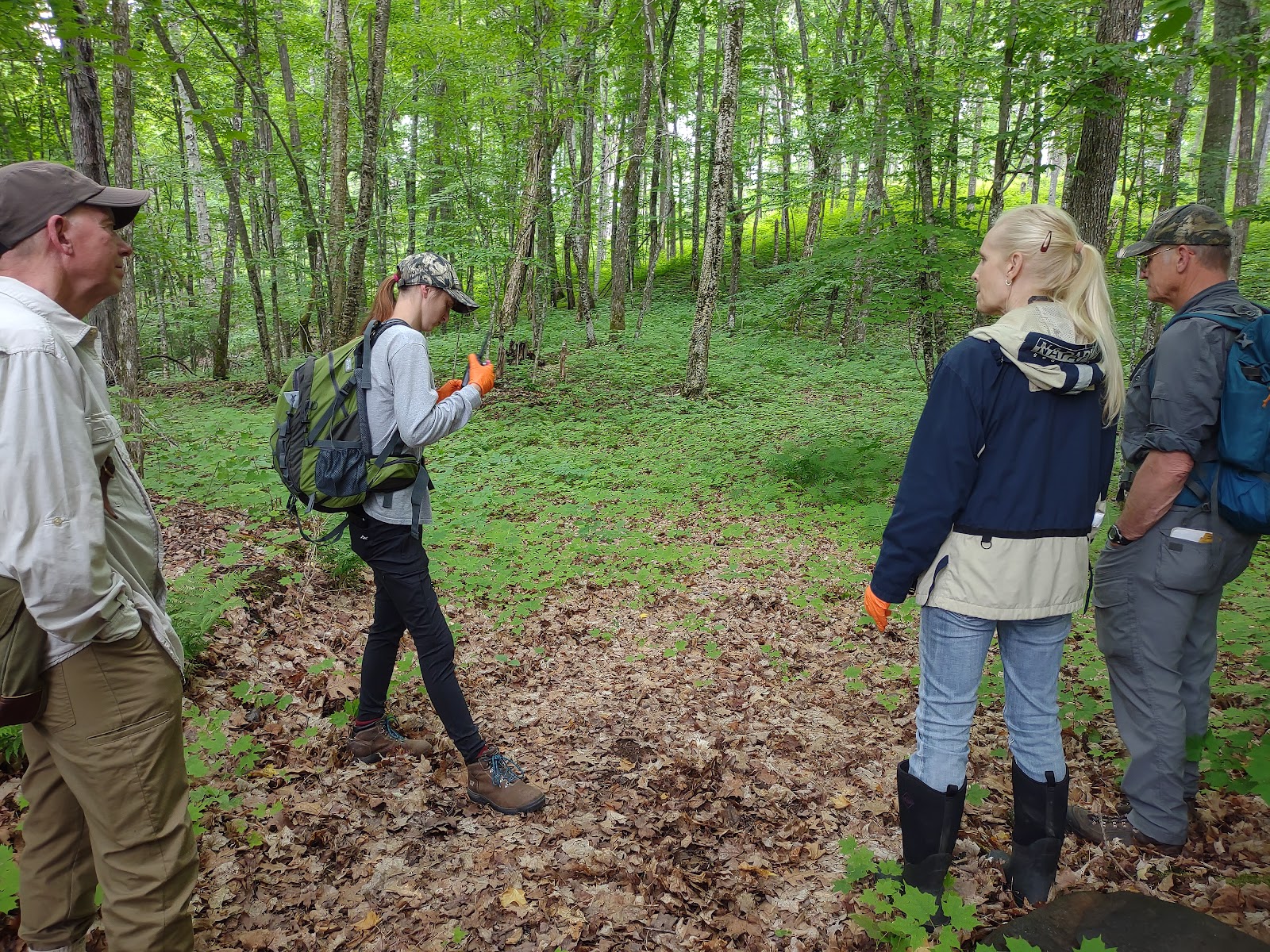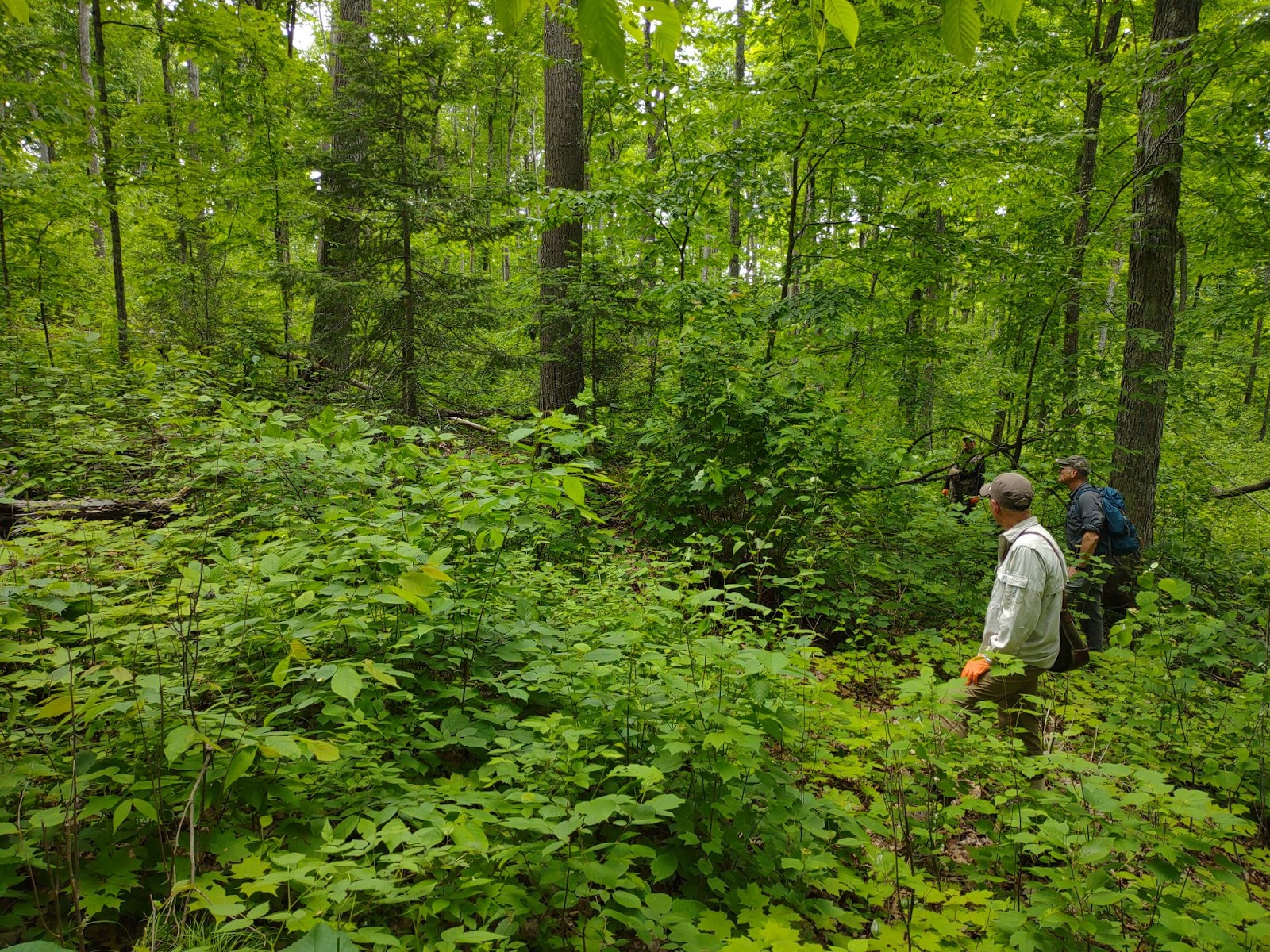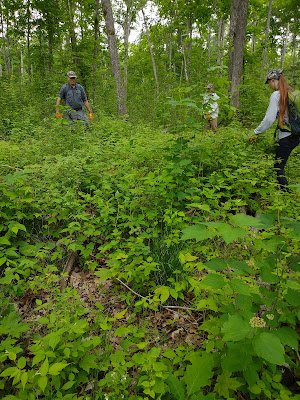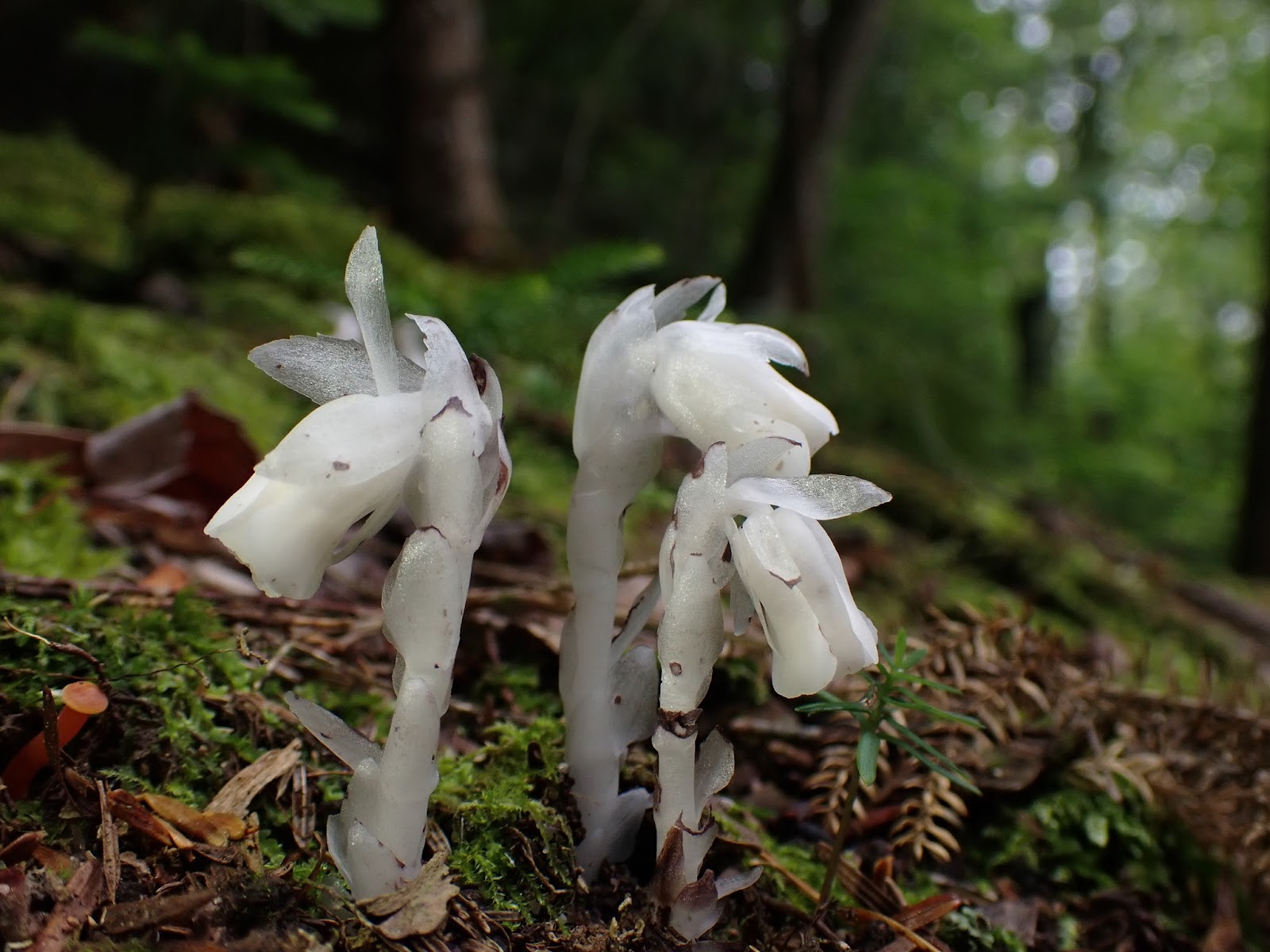 |
| The cool shade of the sugar maple forest was lovely as volunteers waited with Stacey for Josh's signal. |
Stacey Petrus, wildlife biologist with the Wisconsin DNR, scanned the surrounding ridgeline through the scattered trunks, looking for any signs of Josh Spiegel while the rest of the group caught up. Josh, who is the Sawyer County and northern elk biologist for the DNR, had headed up the hill several minutes before us, following the Very High Frequency (VHF) signal from the GPS collar of a cow elk.
The researchers were already familiar with this elk, Cow 448. In the hungry days of winter, they’d lured her and 14 others into an oversized horse corral with some tasty alfalfa and grain mix. Once the elk where chemically immobilized, the DNR were able to utilize a large animal ultrasound and confirm that she was about halfway through a pregnancy that began last September. Then they waited.
If an elk calf can make it through their first year, they have a 92 percent chance of surviving each year after that. The DNR is in year two of a three-year effort to understand the survival rates and mortality factors of that first perilous year. Do the young do better where there’s been a recent timber harvest or other disturbance? How important is it for the maternity habitat to have a view? Is there a habitat type that increases the risk of predation by bears or wolves? To answer these and other questions, they attempt to locate and deploy a GPS collar on 25 calves as soon as possible each spring.
During the Friday night before Father’s Day, Cow 448 recorded a tight cluster of points after a substantial movement away from other elk—a clear indication that she had given birth. A postpartum cow will move the newborn calf away from the location of the birth bed—an area of high scent and disturbance—and then stay relatively close while she feeds and rests. The first task was for Josh to bump the cow a little farther away from the probable location of her calf so that we could search for the young one safely.
 |
| Josh (right) shows the GPS data to Adrian, Randy, and Stacey. |
When he gave the all-clear, we moved up to the hilltop. Josh anchored one end of the search line on the spot where he’d located the cow. We lined up beside him, spacing ourselves to cover the most ground while also being able to see under every bush. Stacey positioned herself on the far end of the line. Their GPS units would help us keep track of the area we’d already covered. Then we began to walk.
 |
| Josh, Adrian, and Randy in the search line. |
The hilltop had been selectively harvested a few years prior to regenerate oak trees, so we parted thick clumps of saplings and stepped over the brittle piles of sticks that had once been the tops of trees. The flat-topped clusters of maple-leaved viburnum flowers shone white in the dappled shade. Raspberry canes tangled our feet. We peered beneath the boughs of young balsam fir and focused our attention so as not to miss the dingy brown of an earnestly hiding calf. Thunder rumbled in the distance, adding to the suspense.
We’d gone 100 yards when Josh called a halt. We reformed the line on his other side and walked back in the same direction we’d just come, covering new ground. I was pushing aside a thicket of paper birch saplings when a murmur went through the line. Adrian Wydeven, a retired Wisconsin DNR wolf biologist, was pointing silently at a spot in a patch of young raspberries about 10 feet in front of him. Success! Josh directed us to form a circle around the calf.
 |
| Adrian, Randy, and Stacey circling the calf. |
Elk this young rely on remaining motionless for safety, Josh explained. Just in case, we were all wearing bright orange nitrile gloves. That way, if the calf bolted, we could gently guide them back to the ground while not leaving behind a scent that might attract a bear.
The calf remained curled in his bed. Stacey deftly slipped a soft blindfold over the little brown face to keep the calf calm. She checked the sex, then rolled the calf into a net bag and hooked that to a scale. At 37.8 pounds, the little guy was above the long-term average birth weight of 35 pounds. Next came the GPS collar encased in a bright red scrunchie to reduce discomfort and protect the elastic belting that will expand with the calf as he grows.
 |
| Stacey and Cynthia collar the calf. |
Josh gently opened the calf’s lips and measured the amount of tooth showing above his gums. This technique provides an estimate of age and confirmed that he had been born on Friday night. Finally, Stacey took a small sample for DNA testing then attached an ear tag. All this took under 15 minutes.
 |
| Josh Spiegel measures an elk calf’s teeth to determine his age while Stacey Petrus readies a DNA sample. Photo by Emily Stone. |
We all moved away quietly while Josh replaced the blindfold with a handful of grass and made sure the little guy would sit tight until his mom returned in a few hours. Elk have a very durable bond, and researchers have found little evidence that our brief disruption of their mother-child relationship will result in abandonment or other negative impacts.
When Josh caught up to the crew, he told us about a calf they’d searched for earlier that morning—and the bear who had found them first. It’s no accident that elk calves and deer fawns are all born at about the same time. Predators may eat many tender meals, but they can’t eat them all, and some will survive. The data we just had a hand in collecting will help us to understand more.
Emily’s award-winning second book, Natural Connections: Dreaming of an Elfin Skimmer, is available to purchase at www.cablemuseum.org/books and at your local independent bookstore, too. Natural Connections 3 is in the works—and needs illustrators from the community! Find out more at: https://www.cablemuseum.org/books/
For more than 50 years, the Cable Natural History Museum has served to connect you to the Northwoods. Our Summer Calendar is open for registration! Visit our new exhibit, “Becoming the Northwoods: Akiing (A Special Place). Follow us on Facebook, Instagram, YouTube, and cablemuseum.org to see what we are up to.















